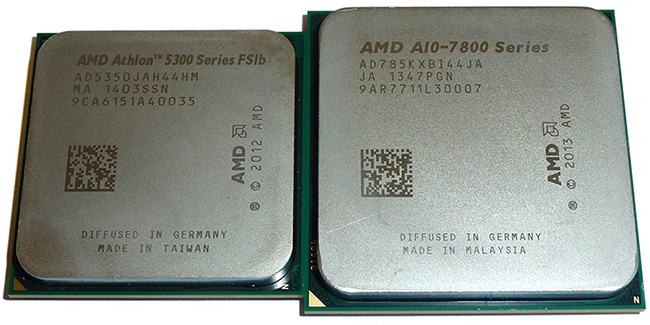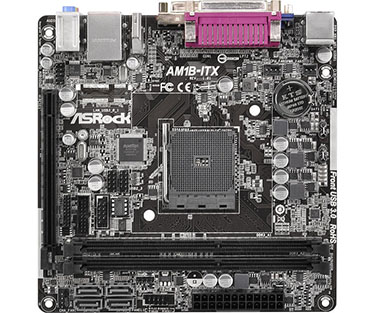Quad-core for the masses
AMD invigorated its desktop Accelerated Processing Unit (APU) lineup recently with the launch of Kaveri parts presented in an FM2+ form factor. Designed to take over from previous Richland and Trinity APUs, these new chips brought the Steamroller core and GCN graphics to play for the first time on the desktop.
Yet Kaveri isn't the first AMD APU to bake GCN graphics into the die. That honour goes to the embedded and laptop-bound Kabini and Temash APUs released last year. Not only that, Kabini also uses low-power Jaguar CPU cores instead of variants of the Piledriver architecture routinely found on desktop APUs.
Kabini chips are APUs in their broadest meaning; they integrate everything into the silicon, including CPU, GPU, I/O, and memory controller. System-on-chip (SoC) is a better term for explaining their design, which makes sense as they go into space- and thermally-restricted environments.
The reason for talking about Kabini in reference to desktop rests squarely with AMD's decision to make these small, low-cost APUs available in socketed desktop form, representing a big deal for system integrators looking to produce inexpensive, feature-rich PCs that are, to an extent, also upgradeable.
AMD's premise is to enable cheaper desktop PCs that still retain full-architecture compatibility with Windows and x86 software. Four socketed Kabini chips and a raft of supporting motherboards are to be made available from today.
Specification
| APU Model | CPU Cores |
CPU Clock (MHz) |
GPU Brand |
GPU Cores |
GPU Clock (MHz) |
Max. DDR3 (MHz) |
TDP (watts) |
Launch Price (US 1ku) |
|
|---|---|---|---|---|---|---|---|---|---|
| 28nm Kabini | |||||||||
| Athlon 5350 | 4 |
2,050 |
Radeon R3 |
128 |
600 |
1,600 |
25 |
$59 |
|
| Athlon 5150 | 4 |
1,600 |
Radeon R3 |
128 |
600 |
1,600 |
25 |
$49 |
|
| Sempron 3850 | 4 |
1,300 |
Radeon R3 |
128 |
450 |
1,600 |
25 |
$39 |
|
| Sempron 2650 | 2 |
1,450 |
Radeon R3 |
128 |
450 |
1,333 |
25 |
$35 |
|
AMD resurrects the Athlon and Sempron branding for Kabini-powered APUs. The Athlon duo and Sempron 3850 all use a quad-core Jaguar CPU configuration in concert with Radeon R3 (GCN) Graphics that are home to two compute units (CUs), totalling 128 cores. The Sempron 2650, meanwhile, uses two CPU cores but retains the full complement of R3 Graphics.
Two characteristics are immediately obvious: they're cheap and they suck on a maximum 25W for the entire SoC. The Kabini architecture can only address memory in single-channel mode, at speeds of up to 1,600MHz, mind, and this will impact upon the potential of the integrated graphics.
Though patently not as powerful as the Kaveri desktop APUs, the feature set is bang up to date. Kabini has DX11.2-class graphics, support for 64-bit computing, a video codec engine and universal video decoder that's on a par with Kaveri, and ability to export to two displays through a choice of HDMI, DisplayPort 1.2, DVI or VGA. Two USB 3.0 ports, eight USB 2.0, and two SATA 6Gbps keeps storage current, as well.
Here's the Athlon 5350 Kabini alongside the A10-7850K Kaveri APU. A smaller die and fewer routing pins means AMD can use a more compact package that makes implicit sense when motherboard real estate is likely to be a premium on mITX boards. AMD isn't divulging die sizes at this moment in time, suffice to say that four Jaguar cores can fit inside one dual-core Steamroller unit found in Kaveri.
AM1 platform
The combination of socketed Kabini APU and FS1b is now referred to as the AM1 platform or package, and motherboard partners have already released a roster of compatible boards. AMD says it has a roadmap that defines the next generation of low-power APUs that will use this AM1 platform.
Consider these AM1 APUs as scaled-down versions of Kaveri, albeit using a different CPU core architecture. AMD expects the cheapest APU-and-motherboard combinations to come in at around $60, with the best at comfortably below $100.
One obvious reason why AMD is keen to roll out these low-priced, low-power, user-upgradeable platforms is because it spies a gap in the market. Intel's price-comparable platform is composed of either Pentium- or Celeron-powered Bay Trail chips pre-soldered onto the board or, stretching it further, LGA1150-based Pentium G-series processors that have higher TDPs. The remainder of the Haswell range of CPUs occupy a higher pricing spectrum.
AMD positions the AM1 platform as the ideal backbone for an entry-level system. We received the premium Athlon 5350 and an ASRock AM1B-ITX motherboard for evaluation. Note the lack of a chipset? This is down to the Kabini APU having everything plumbed in on-die. Having little integration work to do enables motherboard partners to keep costs down, with the cheapest boards starting as low as £20.
Kabini also supports a discrete graphics card by way of a PCIe 2.0 x16 slot. There's no provision for Dual Graphics, however. ASRock spends a little extra cash and houses a further two SATA 6Gbps ports on top of those provided by the chipset.
Video outputs include DVI, HDMI and DVI. Per the specification, two outputs can be used concurrently. ASRock is aiming for a sub-£35 price point with this board.












